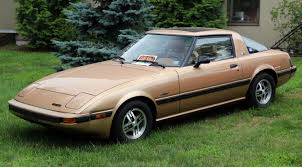-
Insurance
InsuranceAbout our productsLearn about insuringGet a quote Get current values, historical values, model history and more.
-
Valuation
ValuationHagerty valuation toolLook up a vehicle value Get current values, historical values, model history and more.
-
Events
EventsHagerty official eventsHagerty ClubhouseEvent calendar
-
Entertainment
EntertainmentMore to explore
- Portal login
1979 Mazda RX7
Base Coupe 1.1 L
Vehicle values by condition
Fair
Condition 4
£7,200
#4 cars are daily drivers, with flaws visible to the naked eye. The chrome might have pitting or scratches, the windshield might be chipped.
Good
Condition 3
£9,600
#3 cars could possess some, but not all of the issues of a #4 car, but they will be balanced by other factors such as a fresh paint job or a new, correct interior.
Excellent
Condition 2
£15,200
#2 cars could win a local or regional show. They can be former #1 cars that have been driven or have aged. Seasoned observers will have to look closely for flaws.
Concours
Condition 1
£22,300
#1 vehicles are the best in the world. The visual image is of the best car, unmodified, in the right colours, driving onto the lawn at the finest concours.
Insurance premium for a
1979 Mazda RX7 Base Coupe 1146
valued at £9,600
£145.72
/ year*
History of the 1978 - 1986 Mazda RX7

1978 - 1986 Mazda RX7
The first generation Mazda RX-7 (known as the SA22C) was in production from 1978 to 1985, and was a two-door coupe powered by a rotary engine, developed using the principles of Felix Wankel. Styled in house by Matasaburo Maeda, it is a front-engine, rear-wheel-drive sports car that seats two people.
The Mazda RX-7 SA22C replaced the Mazda RX-3, which was a rotary version of the Gran Familia. Unlike its predecessor, it was a two-door sports coupe. It was popular in its native Japan because it was small enough to fit within the dimensions for a low tax car, and rotary engines produced more power than in-line engines under the equally punitive 1500cc tax limit. Its size, weight, and weight distribution also meant that it was an engaging drivers’ car -– chuckable and quick without being expensive to own.
Series 2 models had plastic bumpers, revised tail lights and broad black rubbing strips down the side. The fuel tank grew, and rear disc brakes became optional. UK model cars became known as the FB after 1981, as the start of the chassis number changed to FB from SA22C -– however, these cars are still part of the SA22C era and can be considered here. For 1981, all European cars came with four wheel disc brakes as standard.
For 1983 wheel bolts were replaced by wheel nuts, and the PCD changed to 4x4.5” as per many other Japanese cars of the era.
The 1984 Series 3 was a largely cosmetic facelift. Mazda introduced a turbocharged variant with 165bhp – popular, but rare even when new. These are now the most desirable RX-7s.
The Mazda RX-7 SA22C uses a twin-rotor rotary engine displacing 1146cc -– owing to the different method of power creation, this can be said to equate to a conventional 2400cc engine in terms of power. This engine was coupled to a choice of four or five-speed manuals and three- or four-speed autos, depending upon model year and market. All SA22C RX-7s were rear-wheel drive.
The Mazda RX-7 SA22C is a fun car to chuck about. Light, small, and powerful, it’s got the ultimate mix to make a car exciting in the bends. The rotary engine is smooth and willing, and the gearboxes are excellent. As with all rotary-powered cars, they use oil and are relatively thirsty when compared to similarly sized inline engines, but that doesn’t detract from what is one of the best small coupes of its generation.
With plenty of specialists happy to help you care for your Mazda RX-7, it needn’t be too difficult to maintain. Mechanical spares are relatively easy to source, and if you’re prepared to deal in Japan or America the trim is likely to be easy to source too.
Cars emitting white smoke are on the edge of an engine rebuild, though a little sooty smoke isn’t the end of the world. Wheelarches, floors, door bottoms and the spare wheel well are all prone to rust, and that low wedge-like nose can attract stone chips which corrode to boot.
The rare Mazda RX-7 Turbo is the most desirable of the SA22C era cars. Of the rest, there is scant difference in value, as many are insufficiently bothered by whether their Mazda RX-7 SA22C is a Series 1, 2, or 3 car. Manuals are more desirable than automatics, and the five-speed is predictably preferred.
For other period coupes, try the Triumph TR7, Lancia Montecarlo or even the Porsche 924. For rotary engined fun, try a later RX-7 or even an RX-8 for size. The Mazda Cosmo might also suit, but it’s a larger, softer class of car in general.
Hagerty Newsletter
Get your weekly dose of car news from Hagerty UK in your inbox

ADVERTISEMENT